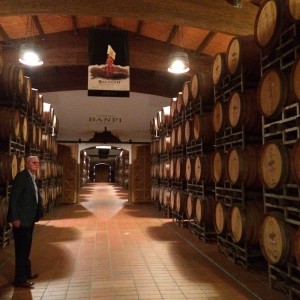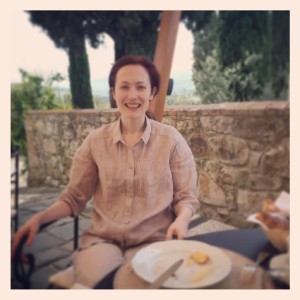We had the pleasure of having a private tour and dinner with Dr. John F. Mariani Jr, Chairman Emeritus of Banfi Vintners, and his lovely wife, Pam, at their breathtaking property Castello Banfi, in Montalcino, Tuscany, on May 11th. I had met their daughter, Cristina Mariani-May Co-CEO, when she gave a staff training at Sherry-Lehmann a few months earlier. Cristina is an extremely impressive person if you have ever had the pleasure to hear her speak, and very generous like her parents; sending me a copy of their book, The Pursuit of Excellence, that shares a lot of their research. Once her father heard that I was interested in their research and I had read the book, he wanted to meet me, and hence, when Ken and I went to Tuscany while John and Pam were there, they welcomed us with open arms.
The picture above is John showing us the winery and some of their research. I cannot do justice to all the advancements they have achieved and are still achieving in a short blog post (quick info for wine nerds who love quality control facts: Banfi became the first winery in 2006 to achieve the ISO 14001 accreditation). Their research spans the vineyard to winery including social responsibility (Castello Banfi estate has a ratio of forest to cultivate land equal to 1.5:1). –Also, I go into a small bit at the end of this blog about some of their research on clones.
John talked about how they were considered outsiders when they first came to Montalcino as Americans, even though that created some initial barriers, through time the Mariani’s family determination to raise the wine quality and perception of the region helped to eventually change local winery owners’ minds into joining forces to improve things for everyone. It was interesting, a friend of mine who had been to Montalcino recently talked to another much more smaller winery owner about Banfi, and he said, “Oh you know they are not really Italian, they are American.” But my friend said he followed it up with giving credit to the Mariani family for making the region the success it is today.
If it wasn’t already too kind of Dr. John F. Mariani Jr himself to give us a private tour, he and his wife invited us to dinner. The dinner lasted over four hours, and it remarkable to hear stories from a man who was a huge part of not only elevating Tuscan wines but also helping to create a wine culture in the United States. It’s one of those events where I kept saying to myself, “Is this really happening to me?” John and Pam could have not been more down to earth. Such warm, inviting people who were the living embodiment of a quote on their website by the co-CEO, their daughter Cristina, “We are selling not just wine, but a way of life. It’s about something slower, calmer, more in touch with family.”
If you ever get a chance to visit Castello Banfi, please do. As you see from the picture above with Ken, it is the real version of what all of us dream about when we dream of Tuscany.
And trust me, every staff member will greet you with a beautiful smile, and bring you delicious food and wine. And you will say to yourself, as I did, why is real life not like this way always.. well that’s okay, if you go to Castello Banfi, at least you get to experience it once in your life.
One of the many things I learned from Banfi is making the sweeping statement that all Brunello is made from the Sangiovese Grosso clone is not completely correct. There are many clones that are used for Brunello. There are over 600 clones of Sangiovese!!!
Here’s some quick info about a little bit of their research on Sangiovese clones.
And it is also important to note that Banfi has always made their research open and available to other wineries. As John said, “A rising tide lifts all boats”… their attitude to success is that lifting up others would help to lift them up as well; a philosophy that I share.
Research was conducted on Castello Banfi’s estate which monitored the quality and yield of three clones which were selected by the “weak selection method”. All of clones (BF 30, Janus 10, Janus 50, and Tin 50) were compared to the same reference clone, grafted on the same rootstock, were cultivated in the same soil and vineyard, trained to spurred cordon, and planted at the same density. These results helped to not only narrow down which clones ultimately would be ideal for their Brunello wines, but also helped to decide where to plant specific clones.
-Results in Extractable Color:
Clones BF 30 and Janus 50 showed more extractable coloring substances, which would appear earlier in the growing season. Janus 10 and the reference clone were slower but more regular with producing extractable coloring substances.
-Results in Climate Adaptability:
Clone Janus 10 had the greatest potential for adapting itself to climate changes during the four-year period, yielding consistent results. The other clones reacted more to climate conditions.
-Results in Aromatic Profile:
Janus 50 had the most intense aromatic profile.














